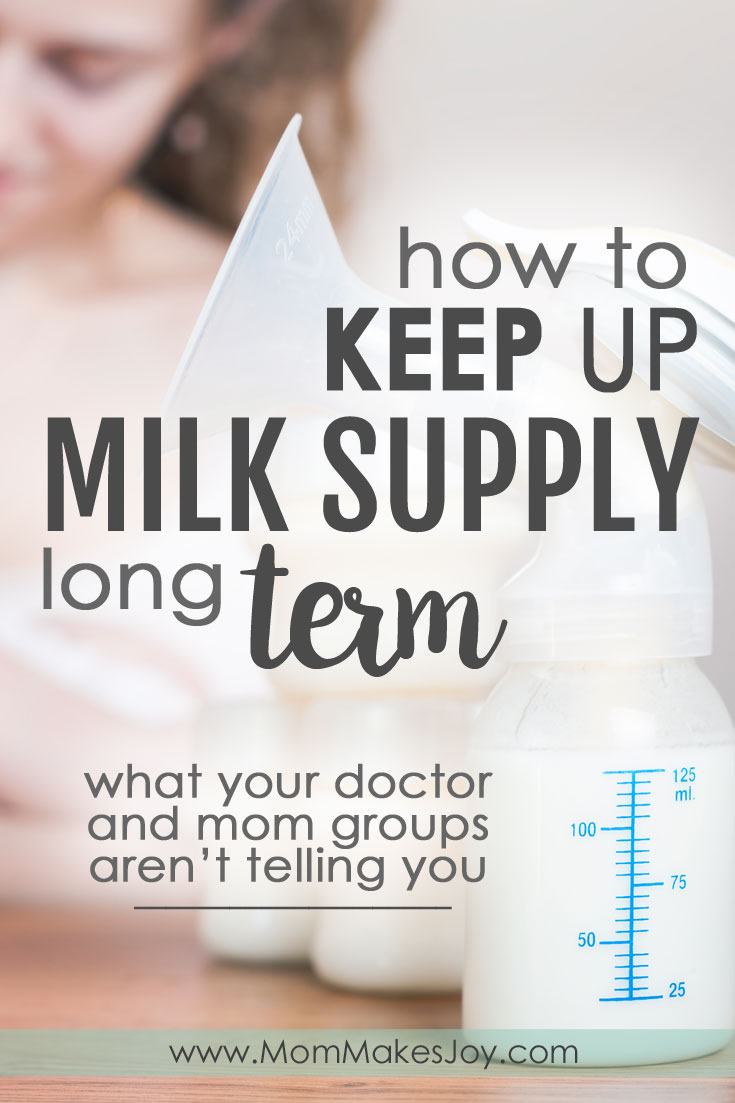The Real Way To Keep Up Milk Supply Long Term
This post may contain affiliate links (full disclosure policy). As an Amazon Associate, I earn from qualifying purchases.
Most new moms I’ve met who hope to breastfeed have one thing in common: They’re nervous.
They’ve heard it was difficult. They saw a friend or relative struggle. They aren’t confident they can do it. Maybe they tried once before and didn’t meet their goals.
As scary as all these feelings are, they’re normal. In fact, I would even go so far as to say they’re good. When worry motivates us to be proactive, it can be a good thing!
If you’re a mom looking for resources to get your breastfeeding journey on track, you’ve come to the right place!

When I was struggling to breastfeed, these articles were the most helpful ones I came across. They answered my most pressing questions and gave me confidence when my resolve was faltering.
Medical Disclaimer: The content of this blog post is not medical advice nor is it a substitute for medical advice, diagnosis, treatment, or professional lactation care. This post is for educational and informational purposes only. It is the reader’s responsibility to review all information regarding any medical condition or treatment with a healthcare provider.
LOW MILK SUPPLY 101
Do you think you might have low milk supply? Did your mom, sister, or friend deal with supply issues? The idea of not making enough milk can be a frightening one, especially for new moms who don’t have many breastfeeding friends or family members to look to for guidance.
The good news is, the vast majority of mothers are physically capable of producing enough milk for their babies! Many “signs” of low supply aren’t actually reliable indicators of true supply issues, and many actual supply problems are instead created by well-meaning–but ill-informed–people providing new moms with bad advice.
You can learn more about the true indicators of low supply in this article here: Low Milk Supply 101 by Emma Pickett, IBCLC

FEEDING SCHEDULE? NO THANKS.
Remember that “bad advice” I just told you about? This is a prime example of it.
Did you know feeding your baby according to a set schedule can actually be more harmful than helpful? Breastfed babies are best fed on demand in order to maintain milk supply. These two articles explain the importance of this very well:
The Dangerous Game of Feeding Interval Obsession by Emma Pickett, IBCLC
The ‘Magic Number’ and Long Term Milk Production by Nancy Mohrbacher, IBCLC, FILCA
“Experts” who recommend feeding baby on a parent-directed schedule with the goal of increasing the amount of time between feeds have been strongly critiqued by the American Academy of Pediatrics. Parent-directed feeding is, unfortunately, not an evidence-based practice and can easily result in low milk supply issues.
PUMPING MOM?
When you see moms post pictures in your mom group of the two eight ounce bottles they pumped that morning, it can be a little disheartening–particularly if you’re only getting, at best, 2-4 ounces.
But did you know that 2-4 ounces is actually normal pump output when you’re pumping for a missed feed? That’s right! Those giant 8-10 oz bottles your friends are pumping are the exception, not the rule.
It’s important to have realistic expectations when it comes to pumping output. You can learn more about what these should be here: How Much Milk Should You Expect to Pump by Nancy Mohrbacher, IBCLC, FILCA
And if you’re having trouble pumping, this may help quite a bit: To Pump More Milk, Use Hands-On Pumping by Nancy Mohrbacher, IBCLC, FILCA

BOTTLE FEEDING?
Bottle feeding has become a norm in our culture, so it may surprise you to know that relatively few people know the proper way to bottle feed a breastfed baby.
Allowing baby to guzzle a bottle at will increase the likelihood that they are being overfed, and very young babies will continue to suck and swallow even when they’ve eaten enough because it is a reflex until about 4 months of age. It is difficult–sometimes impossible–to keep up pumping for a baby taking in more than he needs.
Furthermore, it can make a breastfed baby become accustomed to–and prefer–the fast flow of milk from a bottle and reject the breast, thereby leaving you tethered to a pump even outside of work.
If your baby will be fed bottles of pumped milk, make sure you and baby’s caregiver is familiar with paced feeding!
Kellymom, a highly reputable breastfeeding resource, explains how to do this here: How to Bottle Feed the Breastfed Baby

GALACTOGOGUES – WHAT?
If you believe you might be dealing with low supply, you might be tempted to try things like teas, oatmeal, or brewers yeast to boost your supply. Although moms swear by these remedies (called “galactogogues”), they may not be the best first line of defense against low milk supply issues.
Not only is there very little research to indicate galactogogues are effective, but some herbal remedies (like fenugreek) actually decrease supply in some women!
The truth is, the BEST way to increase and maintain milk supply is frequent and thorough expression of milk from the breasts. According to Kellymom, “To speed milk production and increase overall milk supply, the key is to remove more milk from the breast and to do this frequently, so that less milk accumulates in the breast between feedings.”

So don’t stress out about which lactation cookie recipe is the best or which color Gatorade will do the trick. You could drink a river of Body Armor, but if you are not removing milk often enough, no drink or cookie will fix the problem.
TONGUE AND LIP TIES
If you’re having latch issues or problems with reflux, a tongue tie may be the hidden culprit. Furthermore, tongue ties can cause low supply, since they make it more difficult for baby to stimulate the breast and remove milk properly.
Tongue ties are notoriously difficult to diagnose, since many providers (including pediatricians, pediatric dentists, and ENTs) are not properly trained to evaluate for them–even if they tell you they are.
In fact, tongue ties are so often misunderstood, that I dedicated an entire blog post to them, which you can check out here. In case you don’t believe me, this article explains some of the basics:
Tell Me About Tongue Ties by By Norma Ritter, IBCLC, RLC
Which articles did you find the most helpful in your breastfeeding journey?
Love,
Gabby
P.S. DISCLOSURE: This post may contains affiliate links, meaning I will receive a small commission on products purchased through these links at no extra cost to you. Rest assured I only promote products I use, love, and would recommend to a friend! Please see my FAQs and disclosure policy for more information. Thank you for your support!





